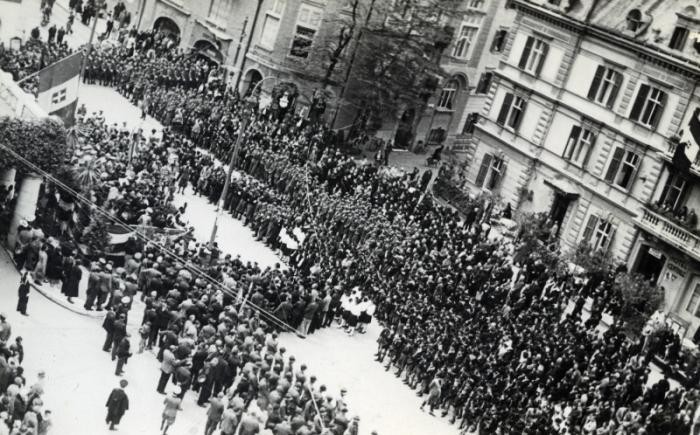
Italy
German policies varied from country to country, including direct, brutal occupation and reliance upon collaborating regimes. Italy was a long-time ally of Nazi Germany.
Key Facts
-
1
Jews had lived in Italy for over two thousand years. The Italian Jewish community was one of the oldest in Europe.
-
2
In 1938, the Italian government under Benito Mussolini began to legislate and enforce antisemitic regulations.
-
3
In 1943, German troops occupied central and northern Italy. German authorities rounded up Jews in major cities in northern Italy.
Background
In October 1922, King Victor Emmanuel III appointed the leader of the Italian Fascist Party, Benito Mussolini, as prime minister of Italy. Over the next seven years, the Fascists established and consolidated a one-party dictatorship.
In two ways, Mussolini failed to establish an absolute dictatorship, however. The Monarchy remained independent of the Fascist Party and continued in theory to be commander-in-chief of the Armed Forces. Moreover, while Mussolini was the recognized leader of the Fascist Party, his leadership remained nominally subject to the approval of a Fascist Grand Council.
The Italian Jewish community, one of the oldest in Europe, numbered about 50,000 in 1933. Jews had lived in Italy for over two thousand years. By the 1930s, Italian Jews were fully integrated into Italian culture and society. There was relatively little overt antisemitism among Italians. Although there were fanatical antisemites among the Fascist leaders, such as Achille Stararce and Roberto Farinacci, Italian Fascism did not focus on antisemitism. Until 1938, Jews could join the Fascist Party.
Antisemitic Legislation
In part under pressure from Nazi Germany and in part fearing that their “revolution” was not perceived as “real” in the Italian population, the Fascist regime passed antisemitic legislation beginning in 1938. This legislation covered six areas:
- definition of Jews
- removal of Jews from government jobs, including teachers in the public schools
- a ban on marriage between Jews and non-Jews
- dismissal of Jews from the armed forces
- incarceration of Jews of foreign nationality; and
- the removal of Jews from positions in the mass media
Although reflected in harsh language on paper, Italian authorities did not always aggressively enforce the legislation, and sometimes interpreted provisions for making exceptions broadly. Even in the internment camps, Jews of foreign nationality lived under bearable conditions: families stayed together and the camps provided schools, cultural activities, and social events.
Nevertheless, for many individual members of a highly integrated Jewish minority which had had reasonably good relations with non-Jewish neighbors, colleagues, and business associates, the psychological insult and real economic disadvantages of discrimination eroded the quality of life, prompting thousands to emigrate, primarily to the Americas, between 1938 and 1942.
World War II
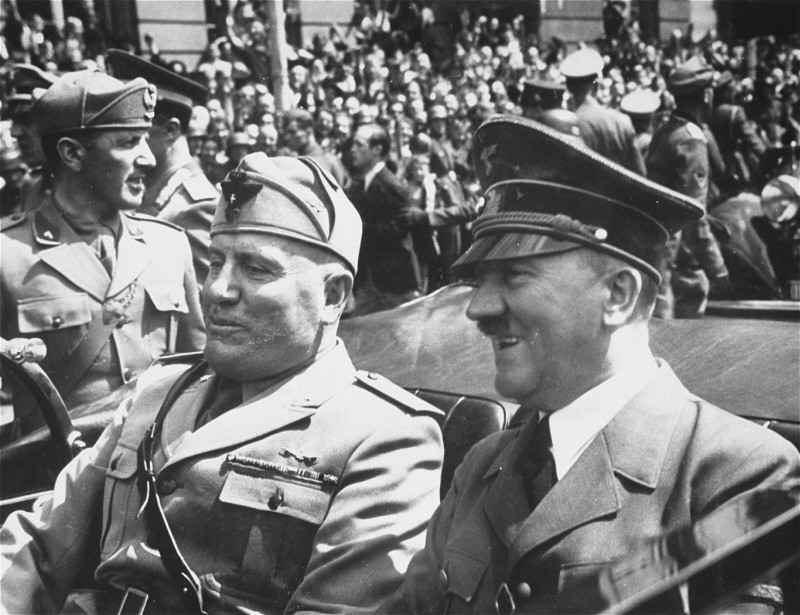
Having formally joined the Axis in 1939, Italy declared war on Britain and France in June 1940, entering World War II as Germany's ally. The Fascist regime hoped to establish a new “Roman” Empire, encompassing the Mediterranean Sea and beyond into North and East Africa and into the Levant (Syria and Lebanon). Italy invaded France in June 1940 and occupied a small strip of land on the Franco-Italian border as part of the armistice agreement with Vichy France in June 1940. In the autumn of 1940, Italy attacked Greece and invaded British-influenced Egypt from bases in Libya, which Italy had conquered from the Ottoman Turks in 1911.
After Italy sustained disastrous defeats in both campaigns, however, the Germans deployed troops in the spring of 1941, conquering Greece and Yugoslavia, and driving the British out of Libya. Italy received the Adriatic coastlines and the corresponding hinterland of Yugoslavia and Greece as occupation zones in the spring of 1941.
Italian-Occupied Areas
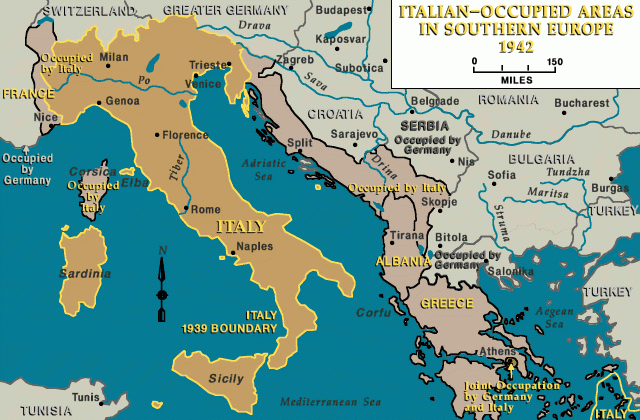
Despite its alliance with Germany, the Fascist regime responded equivocally to German demands first to concentrate and then to deport Jews residing in Italian occupation zones in Yugoslavia, Greece, and France to killing centers in the German-occupied Poland. Italian military authorities generally refused to participate in mass murder of Jews or to permit deportations from Italy or Italian-occupied territory; and the Fascist leadership was both unable and unwilling to force the issue.
Italian-occupied areas were therefore relatively safe for Jews. Between 1941 and 1943, thousands of Jews escaped from German-occupied territory to the Italian-occupied zones of France, Greece, and Yugoslavia. The Italian authorities even evacuated some 4,000 Jewish refugees to the Italian mainland. Incarcerated in southern Italy, these Jewish refugees survived the war.
The Fall of Mussolini and the Italian Surrender
In general, the Italian population did not approve of either the German alliance or the Italian entry into the war. Italian military defeats, the virtual military dependence on German arms, and the failure of the Axis offensive in Egypt in the summer and autumn of 1942 further undermined the legitimacy of the Fascist regime.
The collapse of the North African front, culminating in the Axis surrender in Tunis on May 13, 1943, and the successful Allied landings in Sicily on July 10 induced the Fascist Grand Council to issue a vote of no-confidence on Mussolini's leadership on July 25, 1943. King Victor Emmanuel III used the Council vote as an excuse to arrest Mussolini and appoint Marshall Pietro Badoglio, a former Fascist general, as prime minister. Though announcing Italy's commitment to the Axis alliance, Badoglio secretly negotiated with the Allies during August, reaching a cease-fire agreement on September 3, concurrent with successful Allied landings in southern Italy.
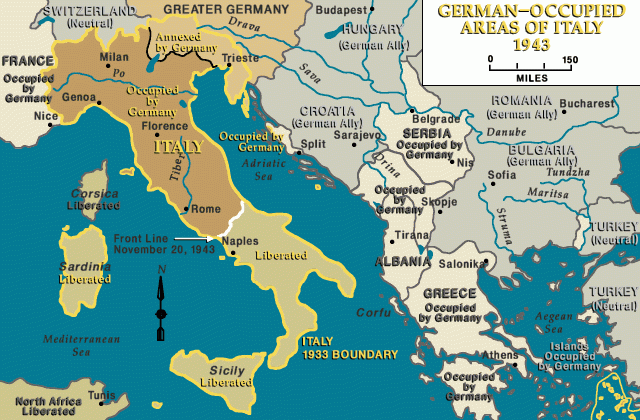
On September 8, 1943, Badoglio announced Italy's unconditional surrender to the Allies. The Germans, who had grown suspicious of Italian intentions, quickly occupied northern and central Italy. German forces also occupied the Italian zones in Yugoslavia, Greece, and France. SS paratroopers freed Mussolini from prison and installed him as the head of a pro-German Italian Social Republic (Repubblica Sociale Italiana-RSI), based in Salò in northern Italy.
The German occupation of Italy radically altered the situation for the remaining 43,000 Italian Jews living in the northern half of the country. The Germans quickly established an SS and police apparatus, in part to deport the Italian Jews to Auschwitz-Birkenau.
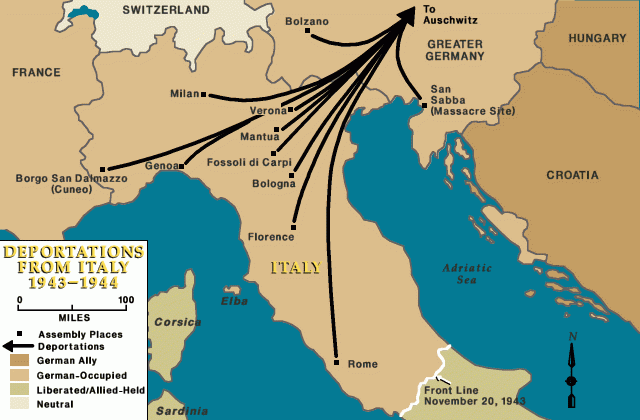
German-Occupied Italy: Camps and Deportations
Roundups
In October and November 1943, German authorities rounded up Jews in Rome, Milan, Genoa, Florence, Trieste, and other major cities in northern Italy. They established police transit camps at Fossoli di Carpi, approximately 12 miles north of Modena, at Bolzano in northeastern Italy, and at Borgo San Dalmazzo, near the French border, to concentrate the Jews prior to deportation.
In general, these operations had limited success, due in part to advance warning given to the Jews by Italian authorities and the Vatican, and in part to the unwillingness of many non-Jewish Italians, including Salò police authorities, to participate in or facilitate the roundups. For example, of approximately 10,000 Jews in Rome, German authorities were able to deport less than 1,100. From the police transit camps in northern Italy, the Germans deported 4,733 Jews to Auschwitz-Birkenau, of whom only 314 survived.
Deportations
The German authorities deported 506 Jewish prisoners to other camps: Bergen-Belsen, Buchenwald, Ravensbrück, and Flossenbürg. The majority of these prisoners were Jewish residents of Libya, some bearing British and French citizenship. The Italian authorities had transported these Jews from Libya to the Italian mainland in 1942 and they fell under German control in September 1943. The Libyan Jews made up the majority of persons sent to Bergen-Belsen (out of a total of 396). Virtually all those sent to Bergen-Belsen, including all of Jews from Libya, survived.
The German authorities deported 328 Jews from Borgo San Dalmazzo via Drancy to Auschwitz, of whom ten survived; and 1,820 Jews from the islands of Rhodes and Kos, of whom 179 survived.
In Trieste, where SS-Brigadeführer Odilo Globocnik, the director of Operation Reinhard (which aimed at the murder of Jews residing in the so-called Government General in German-occupied Poland), became Higher SS and Police Leader in September 1943, the Germans deported about one fourth of the prewar Jewish population. The SS and police established the police transit camp and concentration camp La Risiera di San Sabba in Trieste, where they tortured and murdered about 5,000 persons, most of whom were political prisoners. Using Italian and Slovene volunteers, supervised by selected non-commissioned officers trained at the Trawniki training camp in Poland, the SS and police in Trieste concentrated some 1,200 Jews, mostly from Trieste, in San Sabba, and deported 1,122 from San Sabba to Auschwitz and fifty-five to Ravensbrück and Bergen-Belsen in the autumn and winter of 1943-1944. Of those sent to Auschwitz, eighty-five survived.
In all, the Germans deported 8,564 Jews from Italy, Italian-occupied France, and the islands of Rhodes and Kos, most of them to Auschwitz-Birkenau. 1,009 returned. In addition, the Germans shot 196 Jews in Italy proper, nearly half of these at the Ardeatine Caves in March 1944. Another approximately 100 died in the police transit camps or in prisons or police custody through Italy. More than 40,000 Jews survived the Holocaust in Italy.
Postwar
In late April 1945, Communist partisans captured and executed Mussolini and his mistress, Clara Petacci. German forces in Italy surrendered to the Allies on May 2, 1945.
Despite some tolerated revenge killings in the immediate aftermath of the war, Italian authorities conducted relatively few trials of collaborators, even of those who served the Germans in the Salò regime.
Only since the mid-1990s have the Italian authorities been prepared to conduct a handful of proceedings against Nazi offenders, exclusively Germans and ethnic German auxiliaries. In 1997, an Italian court convicted the former SS officers Karl Priebke and Karl Hass, sentencing them respectively to fifteen and ten years in prison for their participant in the Ardeatine Cave massacre in March 1944. More recently, in 2007, Italian authorities prosecuted Michael Seifert, an ethnic German from Ukraine after his extradition from Canada, on charges of murder perpetrated during his service to the Germans in the Bolzano police transit camp.
Critical Thinking Questions
- Explore Jewish life in Italy before World War II.
- How did the Nazis influence Mussolini and his government?
- How did the course of World War II impact the fate of Jews in Italy?
- What was the relationship between the progression of the war and the mass murder of Europe’s Jews?

